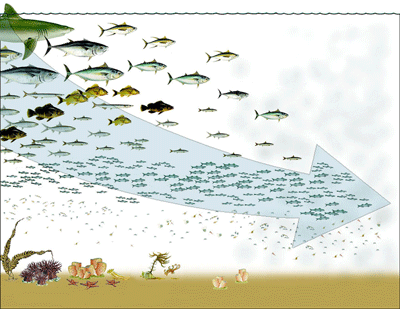‘Fishing down’ is the process wherein, when fisheries target all sizes in an aquatic ecosystem, the abundance of larger and longer lived fishes with high trophic levels decline relative to the abundance of the fishes and invertebrates of lower trophic levels. This process, which can usually be detected through declining trends in the mean trophic levels of the catches from the ecosystem in question, is here illustrated through a variety of regional, national and sub-national case studies. We welcome receiving further case studies of 'fishing down'. The first study to illustrate this on a global scale, and which first coined the phrase ‘fishing down’ on a large-scale, global basis, was by Pauly et al. (1998) in Science.

‘Fishing down’ has been shown to occur in a wide range of freshwater and marine settings. The case studies documented here are presented as examples to allow for an informed debate of the conditions under which fishing down can be masked by extraneous factors, and to enable an assessment of the intensity of this process, once these masking factors are accounted for.
Among the masking factors, the following stand out:
- Taxonomic over-aggregation of catch statistics, where the information on shifting catch composition is hidden by the coarse categories used to report catches; and
- Spatial (and bathymetric) expansion of fisheries, wherein the shifted species composition of catches (e.g., from near-shore, shallow areas) is masked by new catches from offshore and/or deeper areas.
While there is not much that can be done – other than gathering disaggregated data – to document ‘fishing down’ in areas where the catch data are over-aggregated, an indicator has been developed to quantify the spatial and taxonomic expansion which tend to mask ‘fishing down’ (the FiB Index, see Bhathal and Pauly, 2008).
The further development, application and testing of this indicator is now an active area of research, both within and outside the Sea Around Us initiative.
For a discussion of perceived objections to ‘fishing down’, based mainly on imputations and misunderstandings, see The Nature of the Discord.


